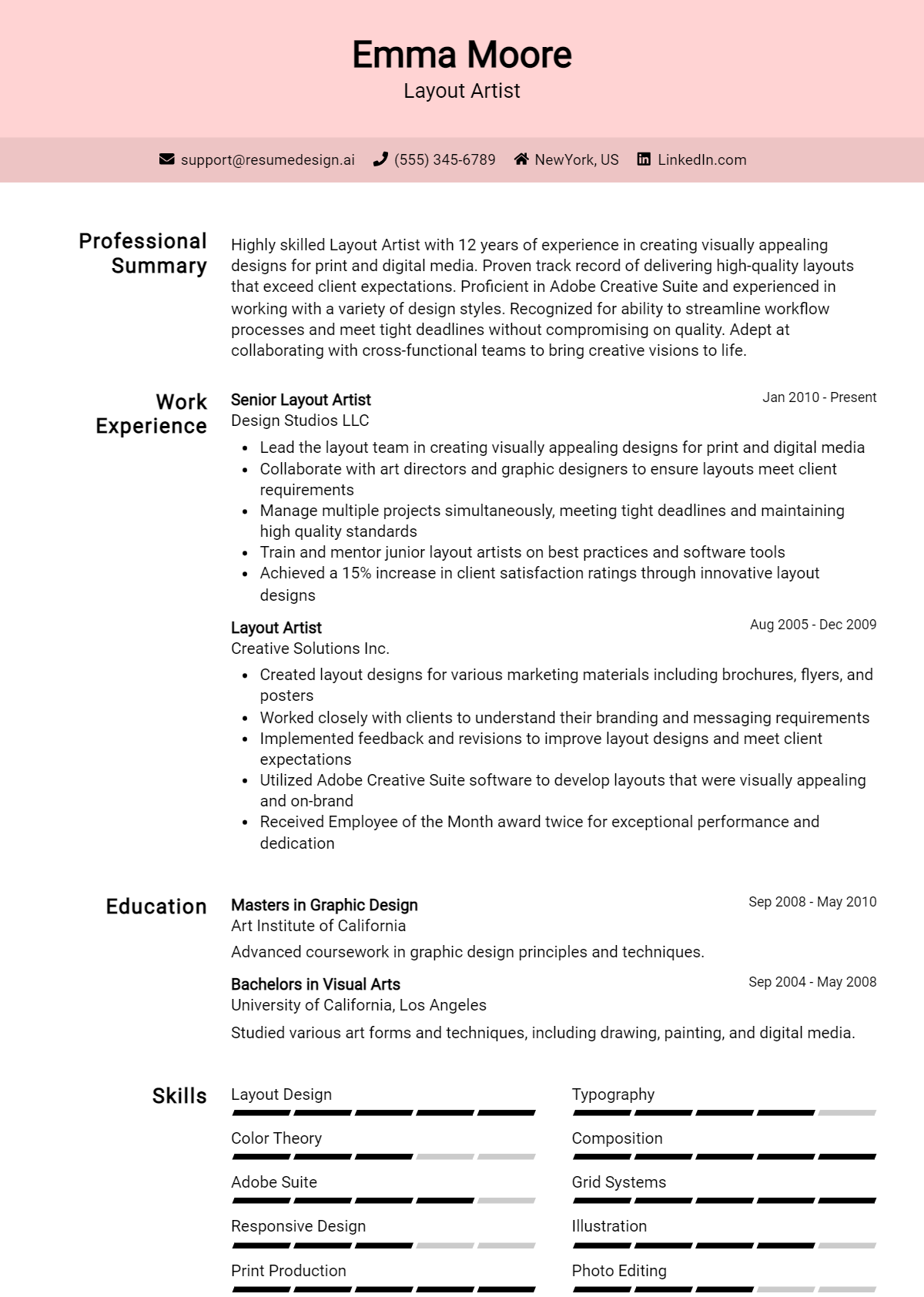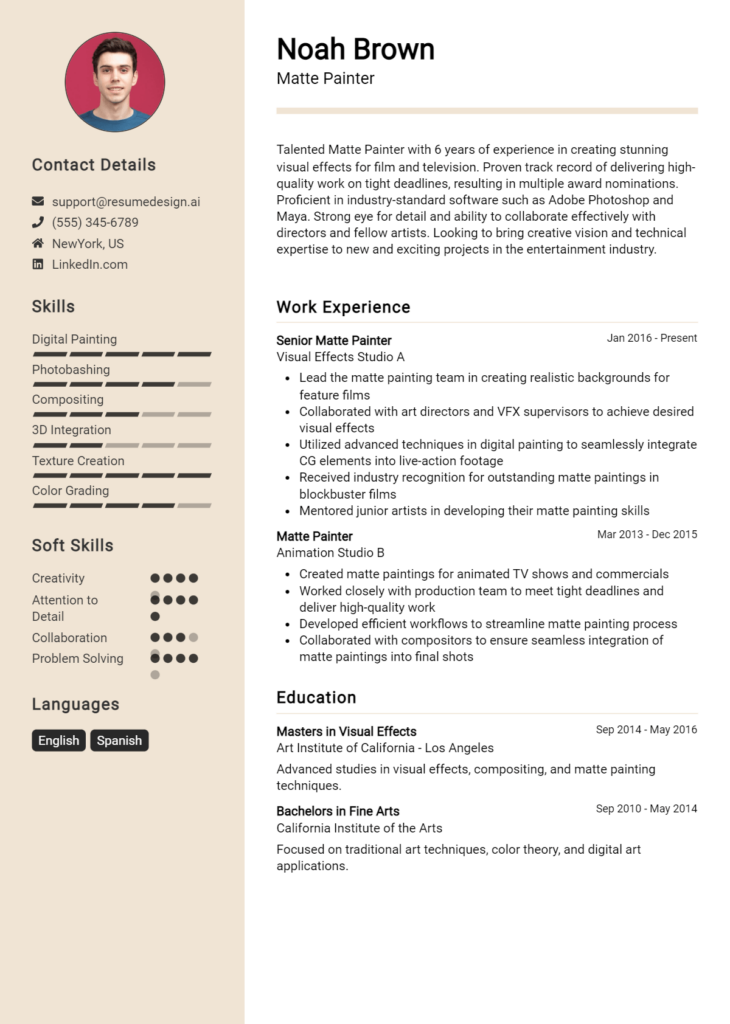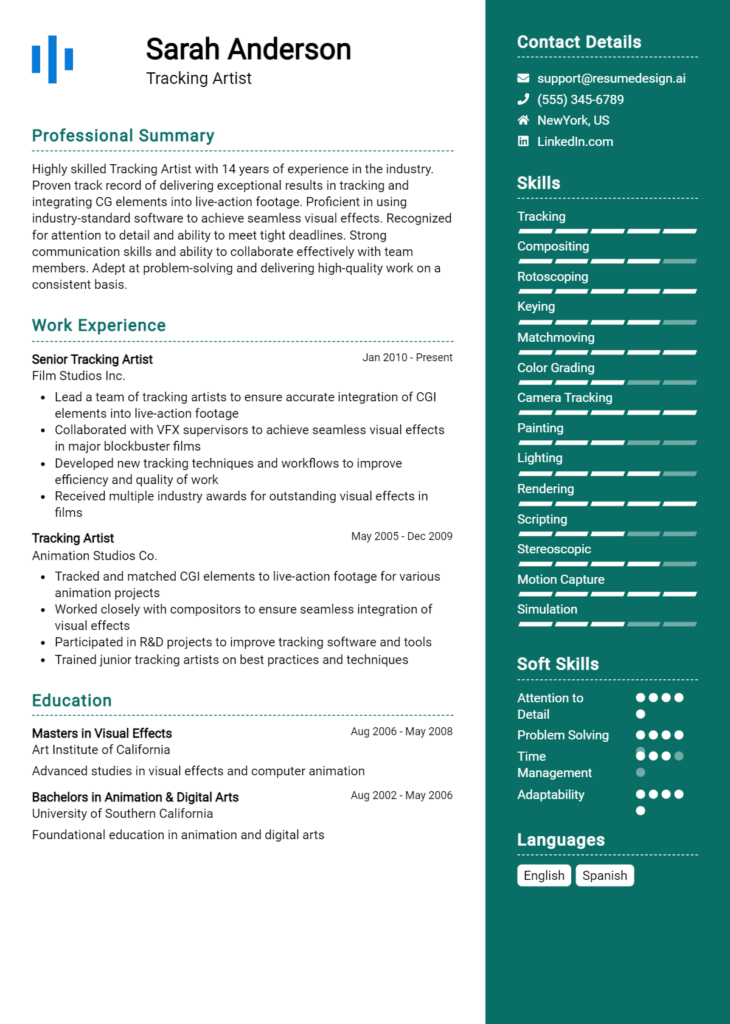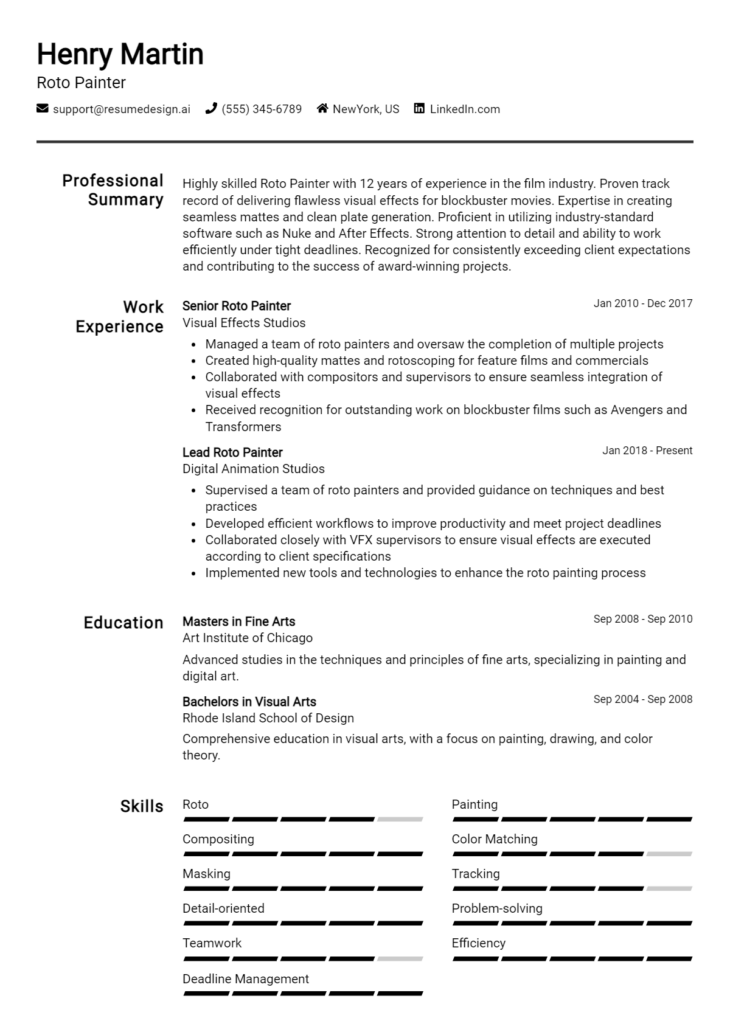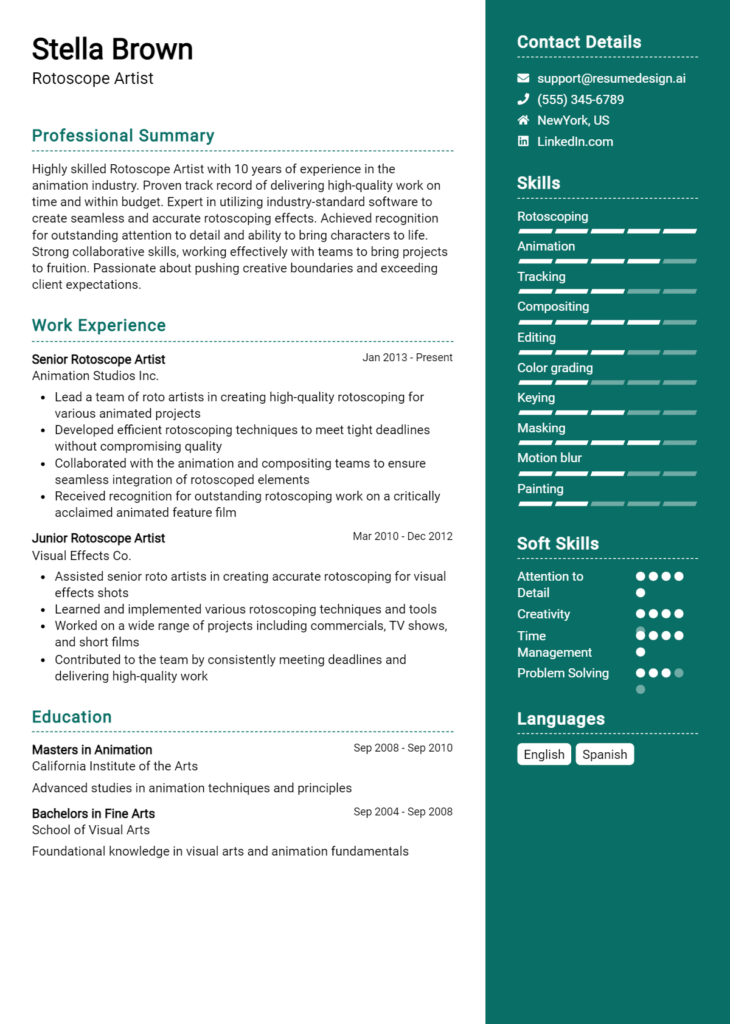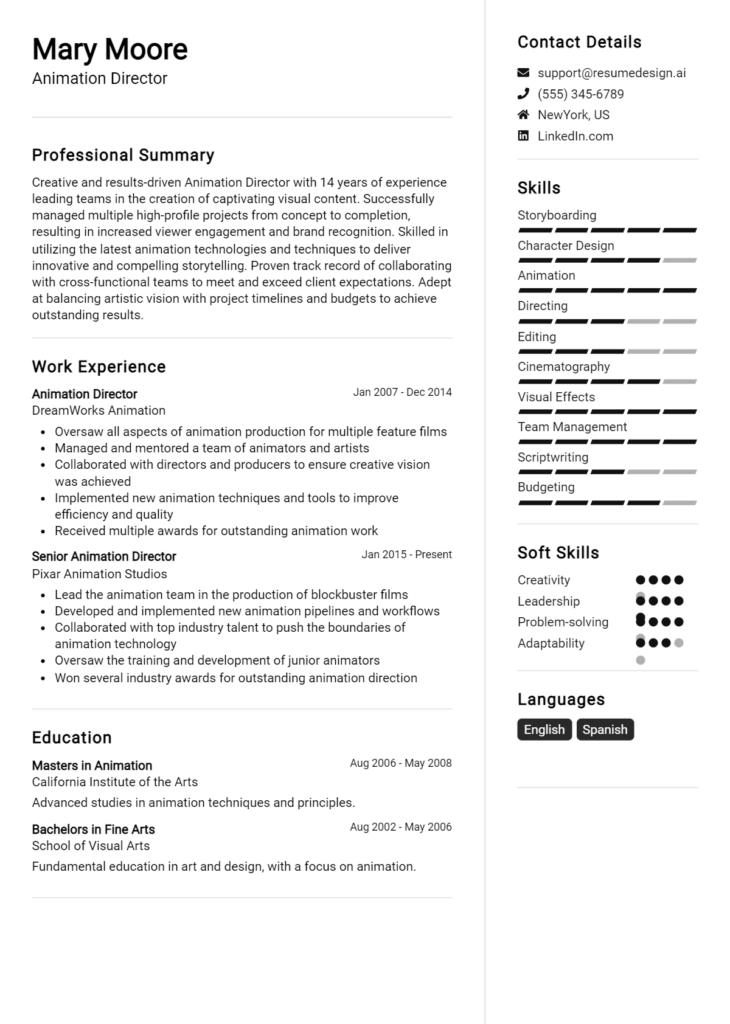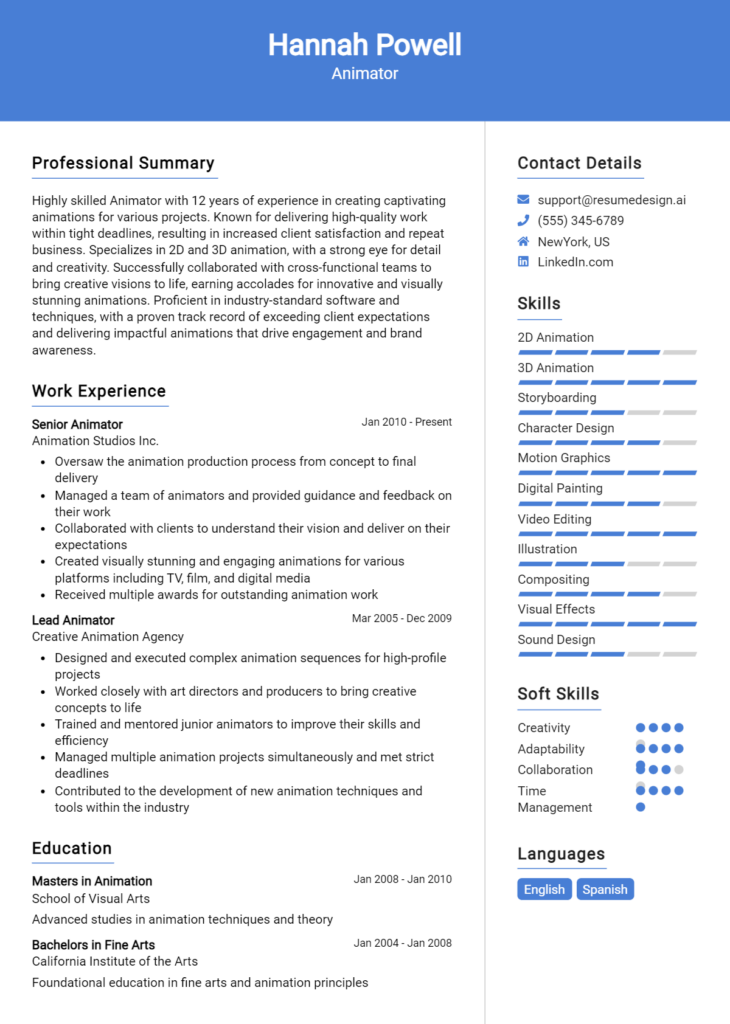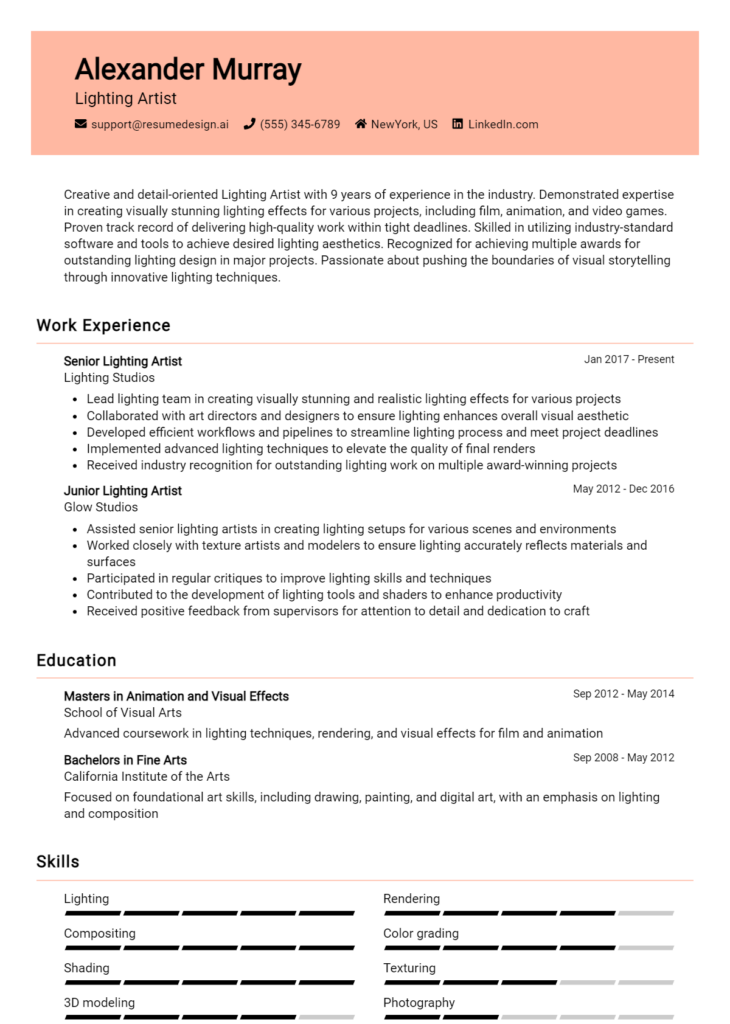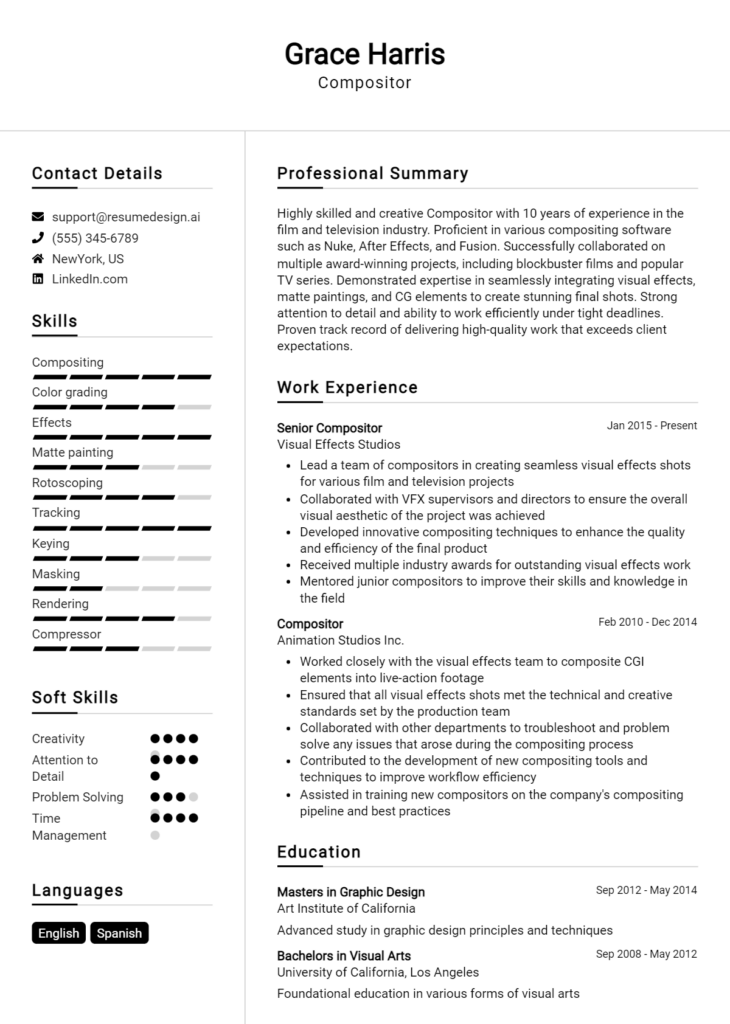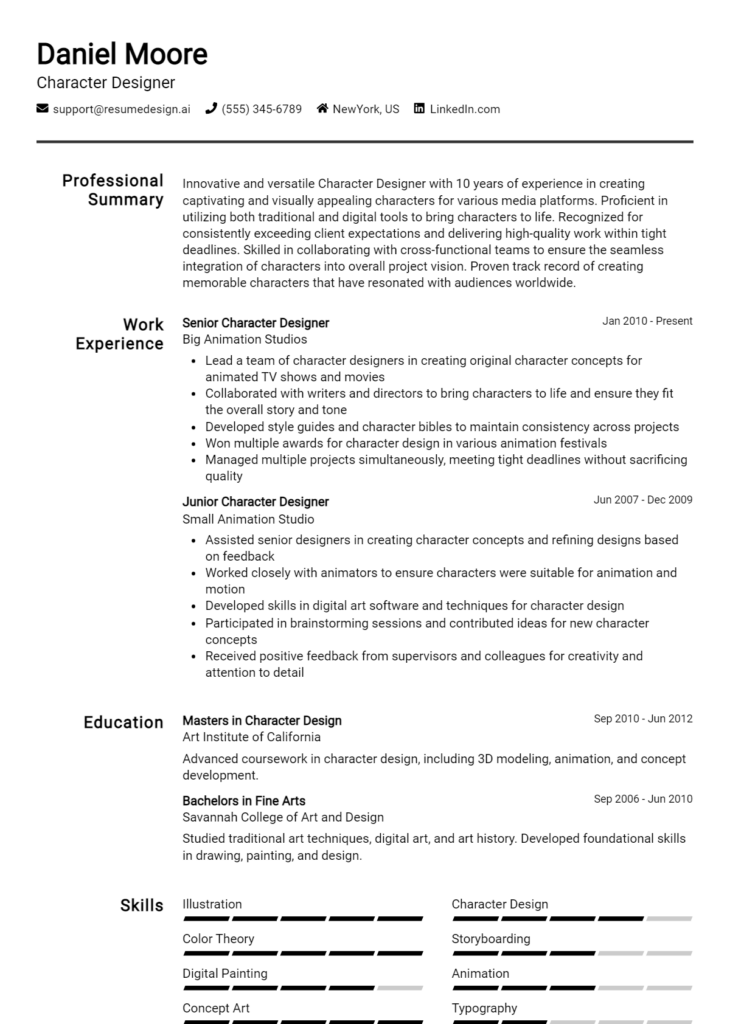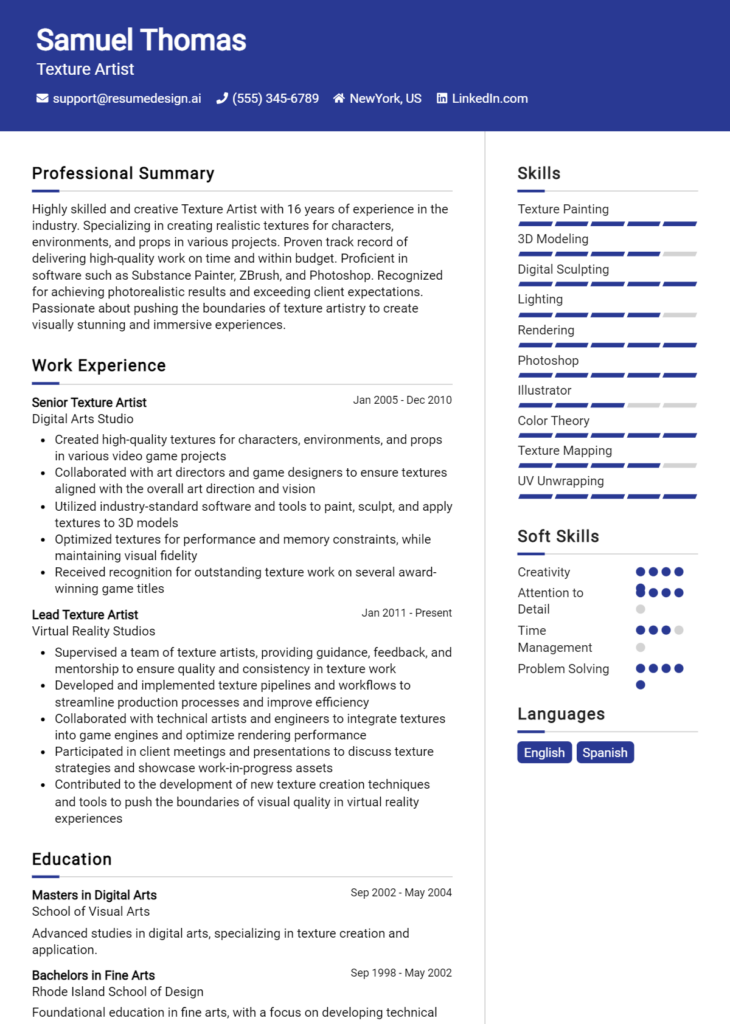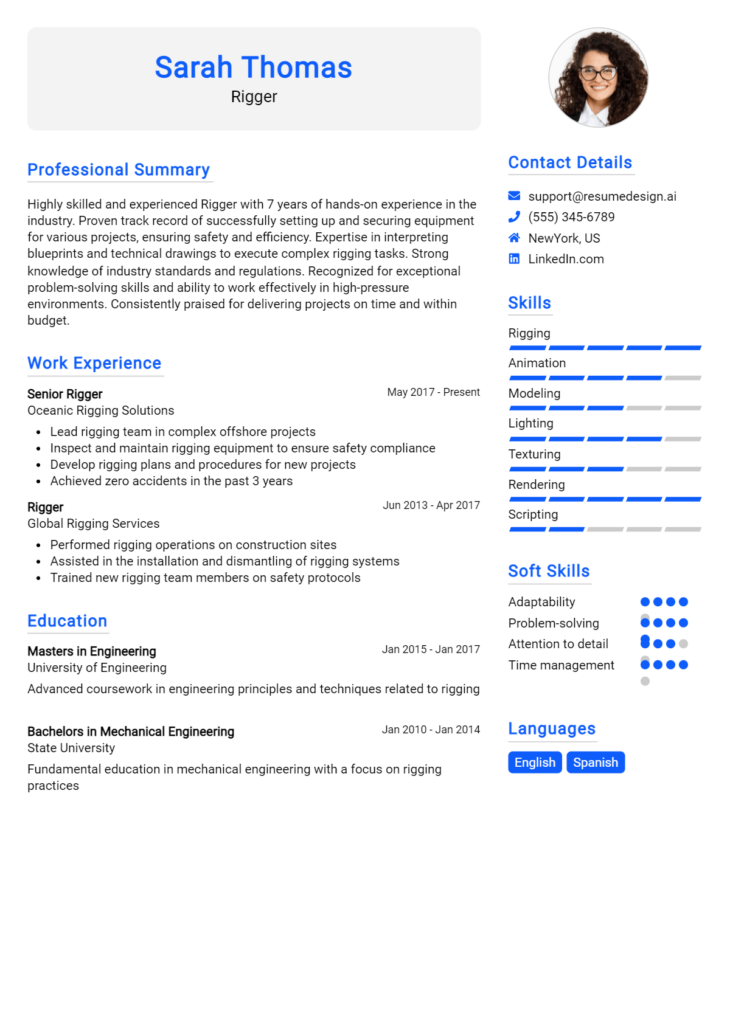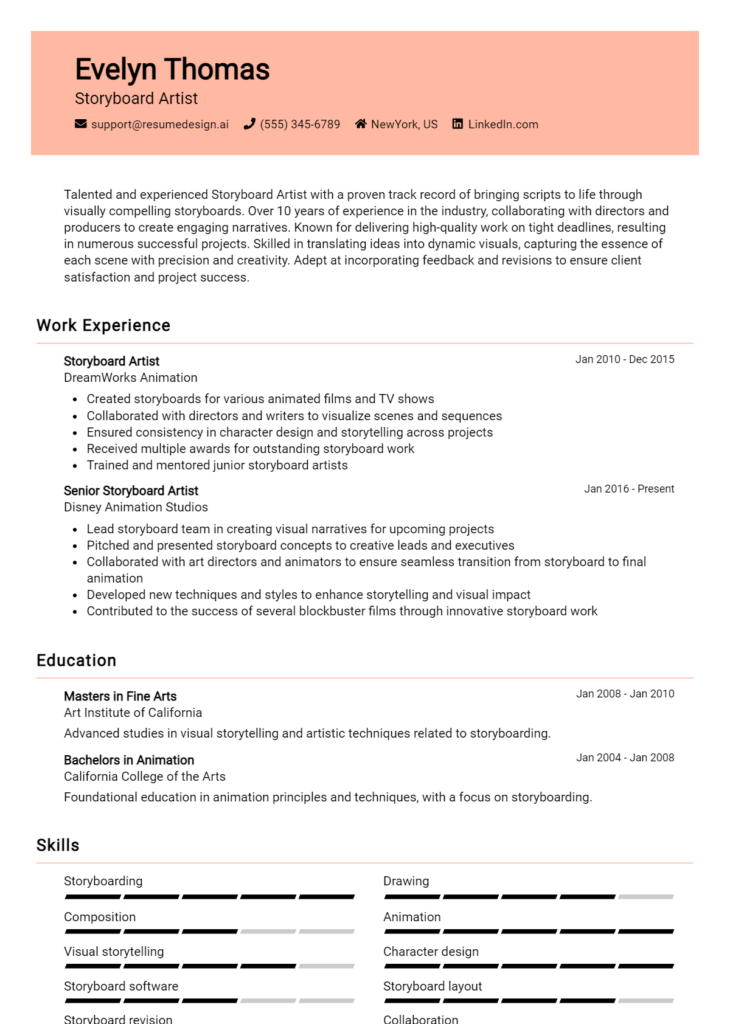Layout Artist Core Responsibilities
A Layout Artist plays a crucial role in the visual storytelling process, bridging departments such as design, animation, and production. Key responsibilities include creating visually compelling layouts, ensuring consistency in style, and collaborating closely with directors and animators. Essential skills encompass technical proficiency in software like Adobe Creative Suite, strong operational abilities to manage project timelines, and problem-solving skills to address design challenges. These competencies contribute significantly to the organization's creative objectives, and a well-structured resume can effectively showcase these qualifications, enhancing job prospects.
Common Responsibilities Listed on Layout Artist Resume
- Design and create layout compositions for animations and films.
- Collaborate with directors and animators to develop visual concepts.
- Ensure visual consistency across multiple scenes and sequences.
- Utilize software tools like Adobe Photoshop and Illustrator.
- Conduct thorough research to inform design choices.
- Present layout ideas and revisions to the creative team.
- Incorporate feedback from stakeholders to refine layouts.
- Maintain organized files and documentation for easy access.
- Stay updated on industry trends and techniques.
- Participate in brainstorming sessions for new projects.
- Assist in the development of storyboards and animatics.
- Ensure deadlines are met without compromising quality.
High-Level Resume Tips for Layout Artist Professionals
In the competitive landscape of the design industry, a well-crafted resume serves as your first and most crucial opportunity to impress potential employers as a Layout Artist. It's not just a document; it's your personal marketing tool that should eloquently reflect your unique skills, achievements, and artistic vision. A compelling resume can differentiate you from other candidates, showcasing not only your technical proficiency but also your understanding of design principles and trends. This guide will provide practical and actionable resume tips specifically tailored for Layout Artist professionals, ensuring that your first impression is a lasting one.
Top Resume Tips for Layout Artist Professionals
- Tailor your resume to each job description by incorporating relevant keywords and phrases that match the specific requirements of the position.
- Showcase your relevant experience by highlighting specific projects you've worked on, including details about your role and contributions.
- Quantify your achievements wherever possible, using metrics such as increased engagement rates or successful project completions to demonstrate your impact.
- Include a portfolio link in your resume to allow potential employers to easily view your work and assess your design style and capabilities.
- Highlight industry-specific skills such as proficiency in design software (e.g., Adobe Creative Suite, Sketch, Figma) and knowledge of typography and color theory.
- Use a clean, visually appealing layout for your resume that reflects your design sensibilities and attention to detail.
- Incorporate testimonials or references from previous employers or clients that speak to your skills and professionalism.
- Keep your resume concise and focused, ideally one page, while ensuring it effectively communicates your qualifications and experience.
- Include relevant certifications or courses that demonstrate your commitment to ongoing learning in the field of layout design.
By implementing these tips, you can significantly enhance your chances of landing a job in the Layout Artist field. A focused and well-designed resume not only showcases your talent and experience but also demonstrates your understanding of the industry and your ability to present information in an engaging manner. Make every detail count, and watch as opportunities begin to unfold.
Why Resume Headlines & Titles are Important for Layout Artist
In the competitive field of layout artistry, a resume headline or title serves as a critical first impression for job seekers. A strong headline can immediately capture the attention of hiring managers, summarizing a candidate's key qualifications in a single, impactful phrase. This succinct representation not only highlights relevant skills and experiences but also sets the tone for the rest of the resume. Crafting a well-thought-out headline that is concise, relevant, and directly related to the job being applied for is essential in distinguishing oneself from other candidates and making a memorable impact.
Best Practices for Crafting Resume Headlines for Layout Artist
- Keep it concise: Aim for one impactful phrase that conveys your unique value.
- Be role-specific: Tailor your headline to the specific position you're applying for.
- Highlight key skills: Include relevant skills that align with the job description.
- Use action verbs: Start with strong verbs to convey your proactive approach.
- Incorporate keywords: Utilize industry-specific terminology to pass through Applicant Tracking Systems (ATS).
- Showcase accomplishments: If possible, reference notable achievements that set you apart.
- Maintain professionalism: Ensure the tone reflects your expertise and the industry standards.
- Avoid clichés: Steer clear of overused phrases that add little value to your profile.
Example Resume Headlines for Layout Artist
Strong Resume Headlines
Innovative Layout Artist with 5+ Years of Experience in Multimedia Design
Award-Winning Graphic Designer Specializing in User-Centric Layouts
Creative Layout Artist with a Proven Track Record in Adobe Creative Suite
Weak Resume Headlines
Layout Artist Seeking Job
Experienced Designer
Strong headlines effectively convey the candidate's specific strengths and relevant experiences, making them immediately engaging and informative for hiring managers. They provide clarity on what the candidate brings to the table, showcasing their unique skills or accomplishments. In contrast, weak headlines tend to lack specificity and impact, failing to leave a lasting impression. By being vague or generic, they miss the opportunity to highlight the candidate's qualifications, ultimately diminishing the resume's effectiveness in a competitive job market.
Writing an Exceptional Layout Artist Resume Summary
A resume summary is a crucial component for a Layout Artist, as it serves as the first impression that hiring managers get of a candidate's qualifications. A well-crafted summary quickly captures attention by succinctly highlighting key skills, relevant experience, and notable accomplishments that align with the job role. Given the competitive nature of the creative industry, an impactful summary should be concise yet powerful, tailored specifically to the job description, and designed to entice hiring managers to explore the rest of the resume.
Best Practices for Writing a Layout Artist Resume Summary
- Quantify Achievements: Use numbers and metrics to demonstrate the impact of your work.
- Highlight Key Skills: Focus on specific skills that are relevant to layout design, such as software proficiency or design principles.
- Tailor to the Job Description: Customize your summary to reflect the required skills and experiences mentioned in the job posting.
- Keep it Concise: Aim for 2-4 sentences that are straightforward and impactful.
- Use Action Words: Start sentences with strong verbs to convey confidence and proactivity.
- Showcase Creativity: Include unique design projects or innovative techniques that set you apart.
- Reflect Industry Standards: Incorporate terminology and trends that are relevant to the layout design field.
- Emphasize Collaboration: Mention experience working with teams or clients, as collaboration is vital in design projects.
Example Layout Artist Resume Summaries
Strong Resume Summaries
Detail-oriented Layout Artist with over 5 years of experience in creating visually compelling designs for print and digital media. Successfully increased client engagement by 30% through innovative layout strategies and strong adherence to brand guidelines.
Creative Layout Artist skilled in Adobe Creative Suite, with a proven track record of delivering high-quality designs under tight deadlines. Led the redesign of a major client’s website, resulting in a 25% increase in user retention.
Versatile Layout Artist with expertise in typography and color theory, specializing in magazine layout. Developed a new layout template that reduced production time by 15%, significantly enhancing workflow efficiency.
Weak Resume Summaries
Layout Artist with some experience in design. Good at working with others and completing tasks on time.
Creative individual looking for a job in layout design. I have a passion for design and like to work on projects.
The strong resume summaries are considered effective because they include quantifiable achievements, specific skills, and demonstrate direct relevance to the role of a Layout Artist. They provide clear evidence of the candidate's capabilities and contributions. In contrast, the weak summaries lack detail and specificity, making them vague and unmemorable. They do not provide any measurable outcomes or unique selling points, which diminishes their impact in a competitive job market.
Work Experience Section for Layout Artist Resume
The work experience section of a Layout Artist resume is crucial as it serves as a platform to demonstrate the candidate's technical skills and their ability to manage teams effectively while delivering high-quality products. This section not only highlights the candidate's proficiency in layout design and software tools but also showcases their capacity to meet industry standards and deadlines. By quantifying achievements and aligning experiences with industry benchmarks, candidates can present compelling evidence of their contributions and value to potential employers.
Best Practices for Layout Artist Work Experience
- Focus on relevant technical skills and software proficiency, such as Adobe Creative Suite, AutoCAD, or Sketch.
- Quantify achievements, using metrics like project completion times, budget management, or audience engagement statistics.
- Highlight leadership roles or team management experiences to demonstrate collaboration and mentorship abilities.
- Include specific examples of successful projects that align with the job you are applying for.
- Use action verbs to convey your contributions clearly and dynamically.
- Tailor your work experience to match the job description, emphasizing relevant tasks and accomplishments.
- Showcase participation in industry-related workshops or conferences to demonstrate ongoing professional development.
- Keep descriptions concise while ensuring clarity on your responsibilities and achievements.
Example Work Experiences for Layout Artist
Strong Experiences
- Led a team of 5 layout artists in the successful rebranding of a major client, resulting in a 30% increase in customer engagement.
- Designed and implemented layout for a high-profile marketing campaign that achieved a 50% increase in conversion rates over previous campaigns.
- Managed project timelines and resources for over 20 successful layout projects, ensuring on-time delivery and adherence to budget constraints.
- Collaborated with cross-functional teams, improving communication and workflow processes, which reduced project turnaround time by 25%.
Weak Experiences
- Worked on various layout projects without specifying any details or outcomes.
- Assisted other artists in their work, but did not mention specific contributions or skills applied.
- Participated in team meetings but failed to highlight any impactful input or leadership.
- Used software tools occasionally without demonstrating any proficiency or achievements related to their use.
The examples labeled as strong are characterized by specific, quantifiable outcomes and clearly defined roles that demonstrate the candidate's leadership, technical expertise, and collaborative efforts. In contrast, the weak experiences lack detail and measurable results, making them less impactful and failing to effectively showcase the candidate's skills and contributions. Strong experiences provide clear evidence of value, while weak experiences leave potential employers with unanswered questions about the candidate's capabilities.
Education and Certifications Section for Layout Artist Resume
The education and certifications section of a Layout Artist resume plays a crucial role in demonstrating the candidate's academic background and industry expertise. It serves as a reflection of the candidate's commitment to continuous learning and professional development, showcasing relevant degrees, specialized training, and industry-recognized certifications. By including pertinent coursework and credentials, candidates can significantly enhance their credibility and ensure alignment with the specific requirements of the job role, ultimately making a compelling case for their qualifications in a competitive job market.
Best Practices for Layout Artist Education and Certifications
- Focus on relevant degrees such as Graphic Design, Visual Arts, or Multimedia Arts.
- Include industry-recognized certifications, such as Adobe Certified Expert (ACE) or similar qualifications.
- Highlight specific coursework that aligns with layout design principles and software proficiency.
- List any specialized training programs or workshops that enhance your skills in layout design.
- Be specific about the institution and the dates attended to provide credibility.
- Keep the formatting consistent and easy to read for better presentation.
- Update this section regularly to reflect new qualifications or learning experiences.
- Use bullet points for clarity, making it easier for hiring managers to scan for relevant information.
Example Education and Certifications for Layout Artist
Strong Examples
- Bachelor of Fine Arts in Graphic Design, XYZ University, 2020
- Adobe Certified Expert (ACE) in InDesign, 2021
- Certificate in Layout and Print Design, ABC Institute, 2022
- Completed coursework in Typography and Digital Imaging, XYZ University
Weak Examples
- Associate Degree in Business Administration, 2015
- Certification in Microsoft Word, 2017
- High School Diploma, 2010
- Coursework in General Studies, ABC Community College
The examples listed as strong provide a clear connection to the skills and knowledge required for a Layout Artist role, demonstrating relevant education and recognized certifications. In contrast, the weak examples fail to align with the industry needs, showcasing qualifications that do not contribute to the candidate's expertise in layout design, thereby diminishing their overall appeal to potential employers.
Top Skills & Keywords for Layout Artist Resume
As a Layout Artist, possessing a well-rounded skill set is crucial for creating visually appealing and effective designs. A strong resume that highlights both hard and soft skills can significantly enhance your chances of landing a job in this competitive field. Employers often look for specific competencies that demonstrate your ability to work with various design software, understand aesthetics, and communicate effectively with team members. By showcasing your skills, you can present yourself as a versatile candidate capable of meeting the demands of any project. To help you craft a compelling resume, here are the essential skills to include.
Top Hard & Soft Skills for Layout Artist
Soft Skills
- Creative Thinking
- Attention to Detail
- Time Management
- Communication Skills
- Team Collaboration
- Problem-Solving
- Adaptability
- Critical Thinking
- Organization Skills
- Artistic Vision
Hard Skills
- Proficiency in Adobe Creative Suite (Photoshop, Illustrator, InDesign)
- Knowledge of Typography
- Experience with Layout Design Principles
- Familiarity with Print and Digital Media
- Understanding of Color Theory
- Ability to Work with Grid Systems
- Experience in User Interface (UI) Design
- Basic Animation Skills
- Knowledge of HTML/CSS (for web layouts)
- Familiarity with Project Management Software
Highlighting these skills on your resume will not only reflect your expertise but also align with the expectations of potential employers. Additionally, don't forget to include relevant work experience that showcases your practical application of these skills in real-world projects.
Stand Out with a Winning Layout Artist Cover Letter
Dear Hiring Manager,
I am writing to express my enthusiasm for the Layout Artist position at [Company Name], as advertised on [where you found the job listing]. With a robust background in visual design and a keen eye for detail, I am excited about the opportunity to contribute my skills to your creative team. My experience in creating compelling layouts that not only capture the essence of a project but also enhance the overall user experience aligns perfectly with the vision of [Company Name].
During my previous role at [Previous Company Name], I successfully collaborated with designers and developers to produce visually striking layouts for various digital platforms. My proficiency in design tools such as Adobe InDesign, Illustrator, and Photoshop, combined with my understanding of typography, color theory, and composition, has enabled me to create layouts that are both aesthetically pleasing and functional. I pride myself on my ability to adapt to different styles and project requirements, ensuring that each design is unique and tailored to the specific audience.
Moreover, I am committed to staying updated with the latest design trends and technologies. I believe that continuous learning is essential in the fast-paced world of design, and I actively seek out opportunities to enhance my skills. I am particularly impressed with [Company Name]'s innovative approach to design, and I am eager to bring my creativity and technical expertise to your projects. I am confident that my passion for design and dedication to producing high-quality work would make me a valuable addition to your team.
Thank you for considering my application. I look forward to the possibility of discussing how my background, skills, and enthusiasm for layout artistry can contribute to the success of [Company Name]. Please feel free to contact me at [your phone number] or [your email address] to arrange a conversation.
Sincerely,
[Your Name]
Common Mistakes to Avoid in a Layout Artist Resume
When crafting a resume as a Layout Artist, it's essential to present your skills and experiences effectively. Many candidates make common mistakes that can undermine their chances of landing an interview. Avoiding these pitfalls will help ensure that your resume stands out for all the right reasons. Here are some frequent errors to steer clear of:
Overloading with Technical Jargon: While familiarity with design tools is crucial, excessive jargon can alienate hiring managers who may not have a deep understanding of the software. Keep technical terms to a minimum and focus on clarity.
Neglecting Portfolio Links: A Layout Artist's work is highly visual. Failing to include links to an online portfolio can hinder your chances, as employers want to see your design style and capabilities firsthand.
Using Generic Templates: Relying on generic resume templates can make your application blend in with others. Customize your layout to reflect your design sensibility and make your resume visually appealing.
Listing Responsibilities Instead of Achievements: Simply stating job duties doesn’t showcase your impact. Highlight specific accomplishments, such as projects that improved user engagement or increased visual appeal.
Ignoring Tailoring for Each Application: Sending the same resume for every job application can be detrimental. Tailor your resume to match each job description, emphasizing relevant skills and experiences for that specific role.
Omitting Relevant Skills: Focusing solely on past job titles can lead to overlooking important skills. Make sure to include both technical skills (like Adobe Creative Suite) and soft skills (such as teamwork and communication).
Providing Inconsistent Formatting: A disorganized layout can distract from your qualifications. Ensure consistent font sizes, bullet points, and spacing to create a polished and professional look.
Neglecting Proofreading: Typos and grammatical errors can undermine your professionalism. Always proofread your resume multiple times and consider having someone else review it for any mistakes you may have missed.
Conclusion
As a Layout Artist, your role is crucial in creating visually appealing designs that effectively communicate ideas and messages. Throughout this article, we've explored the key responsibilities involved, including understanding client briefs, utilizing design software, and collaborating with other creative professionals. We also highlighted the importance of staying updated on design trends and technical advancements to ensure your work remains relevant and impactful.
In conclusion, it's essential to present your skills and experiences effectively in your resume. A strong resume can make a significant difference in your job search, setting you apart from other candidates. We encourage you to take the time to review your Layout Artist Resume and ensure it showcases your best work and aligns with the expectations of potential employers.
To assist you in this process, consider utilizing our comprehensive resources, including resume templates, which can help you structure your information clearly and professionally. Our resume builder allows for easy customization, while our resume examples provide inspiration from successful Layout Artists. Additionally, don't forget to craft a compelling cover letter using our cover letter templates to further enhance your job application.
Take the next step in your career by refining your resume today!

